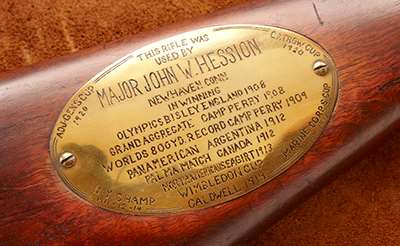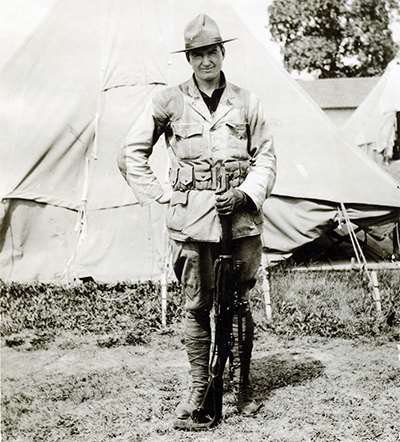
There is a special Springfield Model 1903 in the National Firearms Museum in Fairfax, Va., with a historical backstory everyone should know.
This particular rifle is chambered in .30-’06 Sprg. It was built in 1905 or 1906 in Springfield, Mass. It’s a bolt-action Springfield Model of 1903 with the serial number 264631. Maj. John W. Hession (1877-1961), an American long-range competition shooter, purchased the rifle. He likely bought it in 1906. He topped it with a J. Stevens Co. riflescope and took it to the range. He found the rifle so accurate that he then took it to England to compete in the Olympics in 1908 at the Bisley Range. Then, in 1909, he used the rifle to set a world record at 800 yards at Camp Perry. At the time, The Piqua Leader-Dispatch (a newspaper that went out of business in 1919) ran the headline “World’s Record is Broken By Hession” on its front page. The feat made him a star.
Hession was a top long-range competitor well into the 1940s. He won the Wimbledon Cup in 1932. And that wasn’t his first victory there. The Chicago Daily News Almanac and Year-Book for 1921 lists Hession as the winner of the Wimbledon Cup in 1919 as well. In fact, a Remington ad in Arms & The Man in 1914 boasted that Hession used Remington ammunition to win the Marine Corps Cup Match in 1913.
Clearly, Hession was a renowned rifleman. He also had an understandable attachment to this particular 1903 Springfield. Such a profound attachment, in fact, that what he did with it next was even more remarkable.
After World War I, England passed gun-control laws that mostly disarmed its citizenry. The belief that there should be “a rifle in every cottage,” as proposed by England’s Prime Minister, Robert Gascoyne-Cecil, in 1900, was finished.
England’s Firearms Act of 1920—partly sold to a war-weary public—required an English citizen who wanted to own a gun to first obtain a firearm certificate. The certificate, which was good for three years, specifically listed the firearm a person was approved to own and the amount of ammunition he or she could buy or possess. The police even had the power to exclude anyone who had “intemperate habits” or an “unsound mind.” Applicants also had to convince the police they had a good reason for needing a certificate. The 1920 law did not affect those who owned shotguns, but it gave government officials complete control over who could own handguns and rifles.
In 1933, the English Parliament next passed the Firearms and Imitation Firearms Bill. It increased the punishment for the use of a gun in the commission of a crime. A few years later, the English Parliament passed the 1937 Firearms Act, which extended restrictions to shotguns and granted chief constables the power to add conditions to individual firearm certificates.

Predictably, such restrictions reduced the number of firearms in law-abiding citizens’ hands. Then came the Battle of Dunkirk in 1940. As the German war machine advanced, the British Expeditionary Force evacuated back across the English Channel. That retreat was costly. In their haste, British troops abandoned most of their equipment. The massive loss of military arms, combined with the fact that the English people had been mostly disarmed, left the British people almost helpless before the advance of the Third Reich.
Luckily, they had gun-owning friends across the Atlantic. With a lot of help from the NRA, a group of Americans, headed by C. Suydam Cutting, moved quickly to help re-arm England’s citizens. They established the “American Committee for Defense of British Homes” and ran an ad in the November 1940 issue of American Rifleman that read, in part: “British Civilians, undergoing nightly air raids, are in desperate need of Firearms–Binoculars–Steel Helmets–Stop-Watches–Ammunition.” The ad then said, “If you possess any of these articles you can aid in the battle of Britain by sending these materials to American Committee for Defense of British Homes.”

Hession, who was then working for Winchester Arms, decided to make a statement. He sent his prized Springfield Model 1903 to the American Committee for Defense of British Homes. Before he did, he had two plates attached to its stock. The one on the rifle’s butt read: “This rifle was used by Major John W. Hession” and was used “in winning Olympics Bisley England 1908–Grand Aggregate Camp Perry 1908–Worlds 800 YD. Record Camp Perry 1909 … .” A plate placed on the rifle’s fore-end read: “For obvious reasons the return of this rifle after Germany is defeated would be deeply appreciated.”
Hession’s rifle was shipped to England. Joining it were more than 7,000 private firearms sent by the NRA alone. The U.S. government, of course, sent many more. Congress passed the Lend-Lease Act in March 1941. Almost immediately, quantities of “U.S. Rifle, Cal. .30, M1” and others were headed across the Atlantic.
Winston Churchill was appreciative. He wrote in Their Finest Hour: “When the ships from America approached our shores with their priceless arms, special trains were waiting in all ports to receive their cargoes. The Home Guard in every county, in every village, sat up through the night to receive them ... . By the end of July we were an armed nation ... . Anyhow, if we had to go down fighting … a lot of our men and some women had weapons in their hands … .”
England, of course, was victorious after American troops entered the war and made the difference. And, wonderfully, after the war, Hession’s rifle found its way back to him. It can now be seen in the NRA’s National Firearms Museum in Fairfax, Va.
Go to nramuseum.org to see more of this and other historic firearms.

































